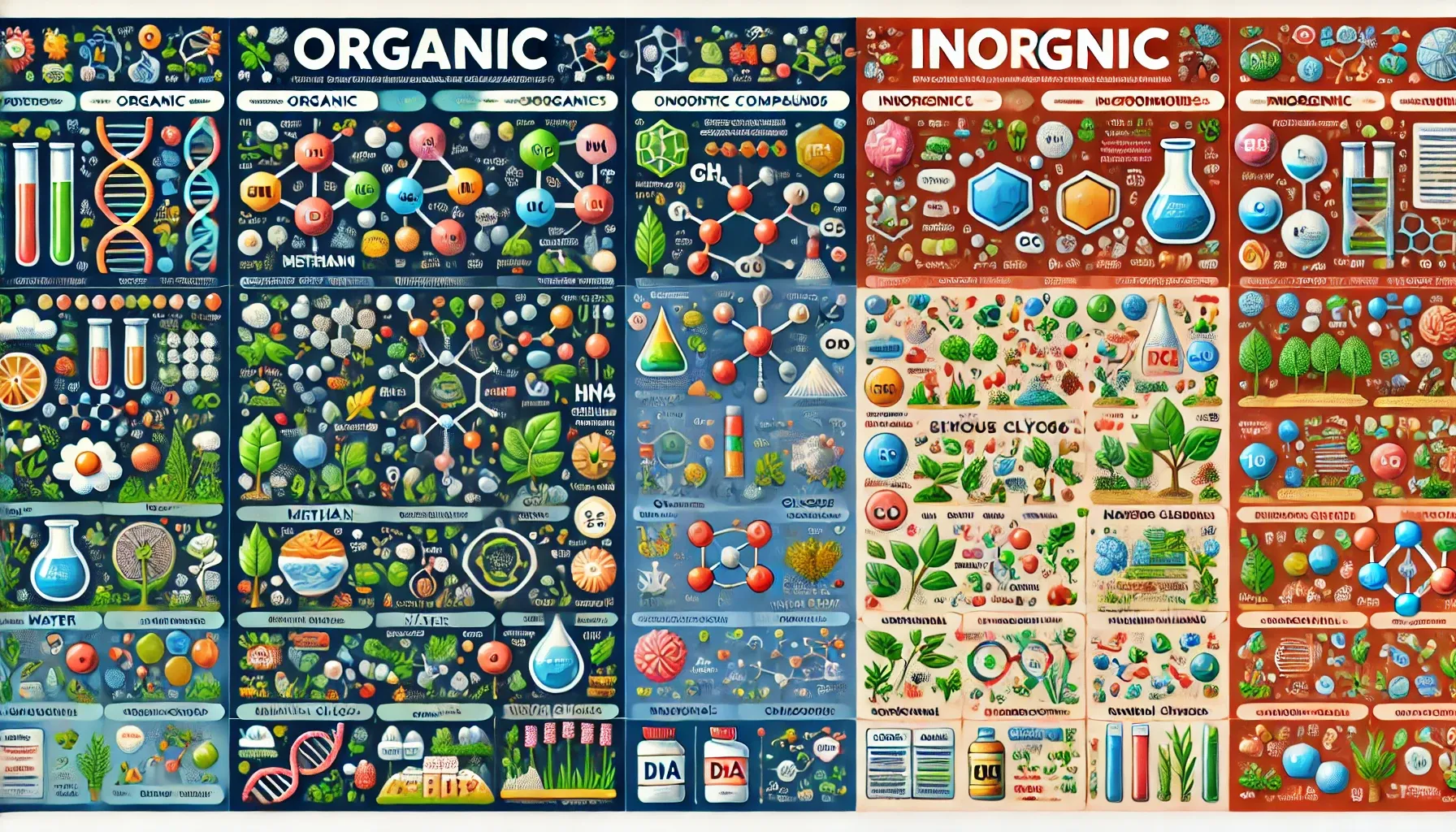Chemistry divides itself into two main branches: organic and inorganic, each focusing on distinct types of compounds. So, what sets apart organic compounds from inorganic ones? Let's examine their definitions, attributes, and crucial distinctions.
What Are Organic Compounds?
These compounds, consisting mainly of carbon (C) atoms intertwined with hydrogen (H) and occasionally mingled with elements such as oxygen (O), nitrogen (N), sulfur (S), and phosphorus (P), serve as the cornerstone of life. They are omnipresent in living beings, fossil fuels, and man-made substances.
{tocify} $title={Table of Contents}
The Characteristics of Organic Compounds
- They boast Carbon-Hydrogen Bonds (C-H) as their signature trait.
- These compounds are prevalent in living organisms, shaping proteins, carbohydrates, lipids, and nucleic acids.
- They exhibit intricate structures and can manifest as lengthy chains (polymers), circular formations, or branched configurations.
- Many organic compounds display flammability; substances like fuels and alcohol ignite readily.
- In comparison to their inorganic counterparts, numerous organic molecules exhibit lower melting and boiling points.
E xamples of organic compounds
- Methane (CH₄) – a component of natural gas
- Glucose (C₆H₁₂O₆) – a sugar pivotal for cellular energy
- Ethanol (C₂H₅OH) – utilized in alcoholic beverages and sanitisers
- Proteins & DNA – fundamental biomolecules crucial for sustaining life.
The captivating world of organic compounds unveils a
tapestry woven with intricacy and significance across various facets of
existence.
What Are Inorganic Compounds?
The inorganic compounds stand apart
as they do not necessarily boast carbon-hydrogen (C-H) bonds, a stark contrast
to their organic counterparts. These compounds are commonly linked with
non-living entities like minerals, salts, and metals.
Characteristics of Inorganic Compounds:
Absence of Carbon-Hydrogen Bonds: While they may
contain carbon in forms such as CO₂, the defining C-H bonds are notably
missing.
Presence in Non-Living Entities: Inorganic compounds
find their home in substances like rocks, minerals, and water.
Ionic or Covalent Bonding: Unlike organic compounds
that lean towards covalent bonds, many inorganic compounds form ionic bonds.
High Melting & Boiling Points: Their robust ionic
or covalent bonding structure contributes to elevated melting and boiling
points.
Electrical Conductivity in Solution: A notable trait
is their ability to conduct electricity when dissolved; this is seen
prominently with various inorganic salts and acids.
Examples of Inorganic Compounds:
1. Water (H₂O) – Known as the universal solvent
2. Carbon Dioxide (CO₂) – Plays a pivotal role in
respiration and photosynthesis
3. Sodium Chloride (NaCl) – Commonly recognized as table
salt
4. Sulfuric Acid (H₂SO₄) – A potent acid utilized
extensively across industries
Key Differences Between Organic and Inorganic Compounds
| Feature | Organic Compounds | Inorganic Compounds |
|---|---|---|
| Carbon-Hydrogen Bonds | Present | Usually Absent |
| Origin | Found in living organisms | Found in non-living matter |
| Types of Bonds | Mostly covalent | Ionic or covalent |
| Complexity | Can be large and complex (e.g., DNA, proteins) | Generally simpler structures |
| Melting & Boiling Points | Lower | Higher |
| Flammability | Often flammable | Mostly non-flammable |
Conclusion
The main difference between organic and inorganic compounds lies in their carbon-hydrogen bonding and association with living or non-living matter. Organic chemistry governs life, fuels, and pharmaceuticals, while inorganic chemistry deals with minerals, metals, and industrial chemicals.
Frequently Asked Questions
Can a compound that is not organic have carbon in it?
Some compounds that are considered inorganic, such as carbon dioxide (CO₂), carbon monoxide (CO), and carbonates (CaCO₃), do include carbon without having any carbon-hydrogen (C-H) bonds, leading to their classification as inorganic substances.
Are all compounds derived from living organisms entirely natural?
Not necessarily. Although many organic compounds occur naturally, like glucose and proteins, there are also synthetic ones like plastics (polyethene) and pharmaceutical medications (such as aspirin).
What makes organic compounds more prone to combustion compared to inorganic ones?
The presence of carbon and hydrogen within organic compounds renders them highly flammable, especially hydrocarbons like methane, gasoline, and various alcohols. On the contrary, most inorganic compounds lack these combustible elements.

